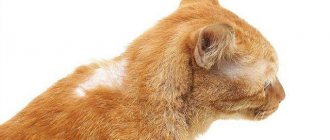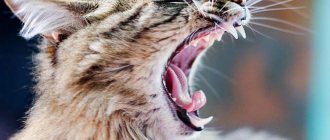15215Administration
If something is wrong with a pet’s health, it always causes serious concern for the owner. It is important to know the reasons why a cat’s hind legs fail and to imagine what measures need to be taken to restore the animal’s normal condition. In such a situation, you simply cannot do without a visit to the veterinarian.
Delay can often cost a cat’s life, which is why even a slight disturbance in gait, and even more so paralysis of the hind limbs, requires urgent treatment. The longer treatment is delayed, the higher the risk that the mobility of the paws will not be restored, or even that the pet will die.
© shutterstock
Hind paw failure: the most common causes
Loss of limb mobility can occur for a variety of reasons. It is extremely difficult for an animal owner to make a diagnosis on his own; a trip to a veterinary clinic will help to adequately assess the condition of a sick cat, completely cure and restore the pet.
- Spinal column injuries.
The hind limbs lose mobility due to spinal injuries. Particular attention should be paid to the lumbar region. A cat walking on the streets can get injured.
The spine can be damaged when hit by a car, bicycle, motorcycle, or falling from a tree or fence. Cats living at home can also injure their spinal column by falling from a ledge or cabinet. Symptoms: the pet drags its back, the tail is motionless, the cat feels weak.
- Thrombus in the femoral artery.
When the femoral artery is blocked (thromboembolism), the pet gradually loses sensitivity in the limbs, the cat suffers from severe pain in the lumbar region, screams, and tries to bite the lower back. Tissue necrosis that accompanies the blockage process leads to complete failure of the hind legs.
Timely therapy provided to the pet in the first hours can lead to complete recovery of the body. Inaction on the part of the owner will result in the painful death of the animal in 3-4 days.
- Tick bite.
Be sure to read:
How to understand that a cat is sick: external signs, how the animal behaves, clear signs of illness, what to do
An ixodid tick bite leads to paralysis and subsequent death. The pathological condition is as follows: after the bite, the cat becomes excited, later the animal begins to feel severe weakness, apathy, continuous trembling spreads throughout the body, and paralysis begins.
Therapy should begin when the pet is excited, otherwise it will be too late.
- Myelitis.
Myelitis (inflammation of the spinal fluid) can develop as a result of infectious diseases, worms, poisoning with harmful substances, or injury.
The pathology is accompanied by the following symptoms: loss of paw mobility, chaotic movements, elevated body temperature, vomiting, diarrhea, involuntary urination. Timely therapy will lead to complete restoration of sensitivity.
- Pathology of the hip joint.
With hip dysplasia, the correct formation of bone tissue is disrupted. Large breed cats are susceptible to the disease.
The pathology causes severe pain when walking, it is difficult for the cat to jump, and the gait changes over time. Without supportive care, the disease can lead to hind leg failure.
- Stroke.
Motor activity may disappear due to a stroke. Blood clots can be present in both an elderly pet and a young pet due to poor diet and sedentary lifestyle.
Blockage of blood vessels in the brain leads to paralysis of the limbs. The sooner the pet owner notices the attack and begins treatment, the greater the chance of a full recovery.
- Heart failure.
Improper heart function can lead to loss of paw mobility. A diseased organ does not provide the required amount of oxygen to the body, resulting in muscle atrophy. Associated symptoms: the appearance of shortness of breath, dry cough, lethargy.
The main diseases that cause the development of paralysis in cats
The main diseases that cause the development of paralysis in animals include:
- Rabies.
- Aujeszky's disease.
- The action of a neurotoxin secreted by the causative agent of botulism.
- In some cases, paralysis is a consequence of salmonellosis.
- Encephalitis and myelitis of any etiology.
- Embolism of regional vessels. In most cases, this leads to necrosis and gangrene, but if partial vascular patency remains, then the first to be affected is the nervous tissue, which is extremely demanding of nutrition and oxygenation.
- Amyotrophic sclerosis, other neurodegenerative pathologies. Approximate treatment plan for a cat with paralysis
The treatment regimen we have given is approximate, and therefore it needs to be “customized” for each specific case.
If the case is severe, you should not expect any special effect, but if the sensitivity and mobility of the affected area are at least partially preserved, there is a chance.
A radical, but very effective method is the subcutaneous injection of a 0.5% strychnine solution. This is dangerous, the procedure should only be performed by an experienced veterinarian! Each cat should have no more than 0.0015 mg of active ingredient. If the animal tolerates treatment well, the dose may be increased to 0.002 mg.
Interesting! The deadly substance in this case plays the role of a stimulant, accelerating the restoration of contractility of nerve tissue and improving the conductivity of damaged nerve fibers.
Sollux lamps and similar medical IR lamps have proven themselves to be effective. The affected area is irradiated for 15 minutes up to 2 times a day. In the summer, the cat is taken outside in the morning and evening, giving him sunbathing. It is important to monitor your pet’s condition to prevent it from overheating and getting heatstroke.
Novocaine blockades. A prerequisite is to use only a warm and fresh 0.5% novocaine solution. If the blockade is done correctly, it speeds up the restoration of nerve fibers by 3-4 times.
At least 3 times a day you need to massage , gently kneading the affected part of the body. In this case, normal blood supply to the lost part of the body is quickly restored.
Rub it with the following composition up to 3 times a day:
- Sodium chloride – 25 g.
- Medical ethyl alcohol, diluted to 70% concentration - 150 ml.
- Medical camphor – 7.5 g.
Signs of limb failure
Symptoms to pay close attention to:
- Complete or partial impairment of motor function. The cat stops moving quickly, drags its limbs, and moves by crawling.
- Changes in gait. “Wobbling” of a small kitten is a normal phenomenon; a similar situation with an adult animal should alert the owner.
- Amyotrophy . Muscles lose elasticity.
- Pain on palpation of the hind limbs. The animal screams in pain if the back of its body is touched.
- Lack of sensitivity. The animal stops feeling heat and cold with its paws.
Be sure to read:
Why does a cat shake with small tremors: reasons, what to do, when to contact a veterinarian
What diseases require massage?
Often massage is prescribed as a rehabilitation tool after suffering or during one of the following diseases:
- closed injuries. Including bruises, dislocations of joints: hip and knee;
- neuritis (occurs due to inflammatory diseases of the peripheral nerves); they are often accompanied by pain and cause a lot of suffering to pets;
- swelling of the limbs;
- arthritis and arthrosis, common diseases in cats. Pets are especially susceptible to them; they are fed by loving owners, and the pets themselves move little. In this case, inflammation of the synovial membrane occurs in the joints. With arthrosis, the joints slowly deteriorate;
- after operations, for quick recovery.
Treatment
When the pet is brought to the veterinary clinic, the doctor:
- conducts an initial examination, determines the degree of sensitivity of the paws;
- prescribes an x-ray examination;
- conducts ultrasound of internal organs;
- takes the animal's blood and urine for analysis.
Treatment is prescribed after diagnosing the disease; therapy includes: medication, physiotherapy, paw massage, and in rare cases, surgery.
Diagnostics
The earlier the diagnosis is started, the greater the chances of curing the animal without fatal consequences. Before scheduling an examination, the veterinarian will find out the following points:
- How long ago did the first symptoms appear?
- gradually or abruptly the animal stopped walking;
- whether the onset of the disorder was preceded by injury or illness.
For extensive diagnostics, the following tests and examinations are prescribed:
- neurological examination with determination of reflex conductivity;
- setting the sensitivity of the hind legs;
- X-ray of the spinal column;
- Ultrasound of the abdominal organs;
- general clinical urine and blood tests;
- MRI of the head and back.
Based on the data obtained, the specialist makes a diagnosis and determines why the cat is walking poorly. In rare cases, additional tests, such as bacteriological culture, are necessary.
Physiotherapy for cats with leg paralysis
The recovery period after paralysis drags on for a long time; in this case, the animal owner cannot do without physiotherapy.
Veterinarians advise performing a daily set of exercises to help restore neurological functions.
- Passive movements. Place the cat on its back and move the paralyzed legs alternately in a circular motion for at least five minutes. The exercise is similar to riding a bicycle.
- Stimulating massage. Stretch your paw pads and limbs daily.
- Scratching. Scratch the paralyzed animal in different places; even with little progress, the cat will try to scratch with its hind paw.
- Using an inflatable ball. Place the cat on its stomach on the ball, so that its paws lightly touch the floor. Roll the ball while holding your pet back and forth.
- Using support. Pass a wide strip of fabric under your pet's belly and try to walk with the animal, holding the ends of the fabric.
- Moving limbs. Take the cat by the hind legs and slowly move them, imitating walking.
- Swimming. Make the cat swim in the bath every day, holding the animal so that it does not choke.
Be sure to read:
What to do if your cat’s ears are red, itchy or spots appear: causes of the disease
Existing types of massage
- Treatment and prophylaxis;
- soothing with a relaxing effect.
Cats will receive this last type of massage regularly, especially from loving owners. Stroking the soft fur brings great benefits to both the pet and its owner; this is a soothing massage for cats. But we’ll talk about the benefits for the owner in another article, but now let’s find out what the benefits of massage are for a cat.
Therapeutic massage for cats is often prescribed by a veterinarian, especially for constipation and many other diseases. In order not to feed your pet medications, you should always start with simpler and more effective methods.
The massage technique depends on each specific case.
Relaxation massage technique
You need to start the massage with circular movements along the spine.
With light, pleasant movements, you need to move in a spiral, massaging only with your fingertips. First the movements go clockwise, then counterclockwise. Gradually you need to increase the intensity of the pressure, depending on the pet’s behavior. The procedure is repeated up to 4 times.
Cats, like humans, also have acupuncture points that are connected to many organs. Exposure to them activates the work of these organs and the mechanism of action of protective forces is activated. From the back of the head to the sacrum you need to apply pressure with your thumbs.
Next, you can massage the head, starting from the base of the skull. Massage is performed with light circular movements of the fingertips. Gradually the pressure increases. Stroking and pressing should be pleasant, they will make the cat relax and go limp. Now you can move on to massaging the front side of the neck, but the area of the pharynx and trachea should not be touched. In those places where the lymph nodes are located, you also need to massage with caution, avoiding strong pressure.
Contraindications for carrying out
Despite the undeniable benefits of massage, in some cases it still cannot be done. Let's look at exactly what cases.
- If the cat has just been injured or seriously damaged. In this case, with dislocations and fractures, the help of a veterinarian is needed. If a bruise occurs, the cat needs to be given time to rest. Perhaps apply cold to the sore spot.
- You cannot do massage for viral diseases that occur in acute form.
- When there is a high temperature. In cats it is higher than in humans, but the mark of 39.5 ◦C can already be considered critical. In this case, you will need the help of a doctor.
- In the presence of cancer. In this case, the spread of neoplasms can be provoked.
- If there is a violation of the skin: dermatitis, wounds, ulcers, tumors.
- If the venous walls are enlarged, it is also better to avoid the massage procedure.
- If your pet's skin is affected by a fungal disease.
- In case of arthritis in the acute phase, massage cannot be performed, as this can provoke an increase in the inflammatory process.











